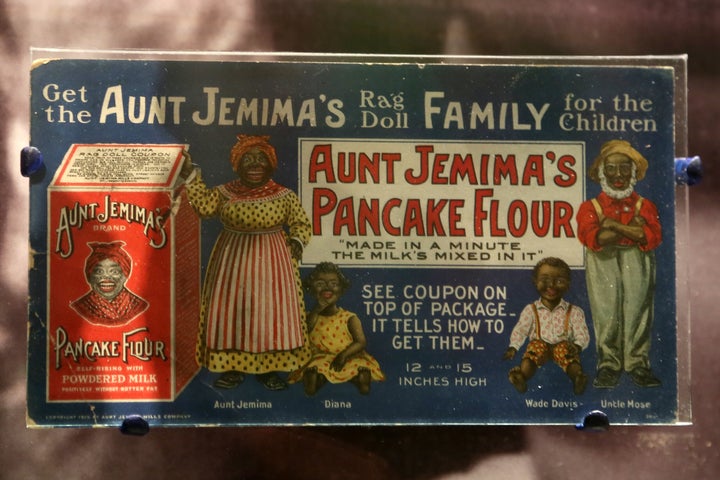WASHINGTON -- At this year’s MTV Video Music Awards, host Miley Cyrus appeared in a pre-taped segment with hip-hop artist Snoop Dogg and her own grandmother. Snoop told Cyrus that her “mammie” -- which has evidently long been Cyrus' affectionate nickname for her grandma -- had made the marijuana brownies they were eating.
When the segment was over and the broadcast returned to Cyrus live onstage at the VMAs, she introduced Snoop as -- and we'll give her the benefit of the doubt with the spelling, here -- “her real mammie.” To many people, it sounded like Cyrus was calling Snoop her "mammy" -- a term that's inseparably bound up with the painful history of African enslavement.
The remark prompted an immediate Twitter backlash, most prominently from the Chicago emcee Chance the Rapper, who posted a photo of Hattie McDaniel in "Gone with the Wind." In that film, McDaniel played a character, literally named Mammy, who was Scarlett O’Hara’s house slave and personal servant.
Representatives for Cyrus didn't immediately return a request for comment.
To set the record straight, here's why it's a bad idea to call anyone, especially a black person, your "mammy," or any word that sounds like "mammy." Most Americans in the year 2015 have at least a vague sense that you're not supposed to do this, but fewer know the full context.
The mammy -- an archetype of a black domestic servant often depicted as good-natured, overweight and loud -- is arguably the most enduring image from the days of Jim Crow. She “began life as a caricature, a lie, a piece of propaganda that sought to portray black women as (mostly) ignorant, physically ugly, servants; obedient and loyal to her white ‘superiors,’” said David Pilgrim, the founder and director of the Jim Crow Museum at Ferris State University, in an email to The Huffington Post. Pilgrim's museum, in Big Rapids, Michigan, has acquired more than 100 Jim Crow-era items depicting mammy caricatures.
Outspoken and dominant, the mammy stood out in personality almost as much as she did in stature. She was, in essence, a parody of black women rooted in white perceptions.
“She was offered, in and to the popular imagination, as proof of black acquiescence to white superiority and black inferiority," Pilgrim told HuffPost. "She loved her white family. She loathed her own black family... She was so distant from white male sexual interests that she was evidence that white men did not desire black women, did not sexually assault black women. This, too, was the lie of mammy.”

The truth is that white people created the mammy -- along with other insulting caricatures like the simple, docile Sambo; the jubilant, apelike coon; and the savage brute -- as a way to turn black people from human beings into something less than that.
During the antebellum era, only the wealthy could afford to have black women as house servants, since most slaveowners needed their enslaved Africans out in the field. In contrast to the classic mammy figure, who is plus-size and middle-aged, these real-life house servants were usually slender, young and of mixed race. Historically, these "mammies" were often forced to serve as concubines for the white master of the house. Slave owners sexually assaulted black women who worked for them. This happened especially often to younger, lighter-complexioned women who hewed more closely to European beauty standards. But all black women, regardless of age or body type, were at risk of having their bodies exploited by the white men around them.
One reason that fictional mammies have differed so widely from their real-life counterparts is rooted in "the complex sexual relations between blacks and whites," Pilgrim writes on the Jim Crow Museum’s website:
The mammy caricature was deliberately constructed to suggest ugliness. Mammy was portrayed as dark-skinned, often pitch black, in a society that regarded black skin as ugly, tainted. She was obese, sometimes morbidly overweight. Moreover, she was often portrayed as old, or at least middle-aged. The attempt was to desexualize mammy. The implicit assumption was this: No reasonable white man would choose a fat, elderly black woman instead of the idealized white woman. The black mammy was portrayed as lacking all sexual and sensual qualities. The de-eroticism of mammy meant that the white wife -- and by extension, the white family, was safe.
The mammy "was designed to... assist the white Southern mistress in terms of cooking and taking care of the home and family," Charlene Regester, an associate professor in the Department of African, African American, and Diaspora Studies at the University of North Carolina at Chapel Hill, told HuffPost. "Some people have argued that she was rendered unattractive, because of her size and weight... so that she would not be a [sexual] threat to white womanhood."
Indeed, one of the mammy's traditional responsibilities was to defend white womanhood by standing between the mistress of the house and her suitors. It was part of the mammy's role of being docile, loyal and protective toward the white people in her life.
With her bastardized English, her dominance over black men and her exaggeratedly, cartoonishly black attributes, the mammy figure was created to reinforce the idea that black people cannot mesh with white America. She was a prop, used for exactly the same purpose as all racial stereotypes everywhere -- to keep the powerful in power, and the powerless in their place.
The harmful influence of the mammy figure didn't end with the abolition of slavery. The legacy of the idea stretched into the Jim Crow era, when black women often had to work as house servants if they wanted to work at all, and it still has currency today, as the actress Viola Davis noted in an interview last year. Unskilled, undesirable, good-natured, simple-minded -- these ideas about what black women are, or what they should be, have shaped social expectations for black women and made their opportunities smaller than they'd be otherwise.
By definition, the mammy is a subservient figure: someone defined by her relationship to whiteness, someone who's perfectly happy being a second-class citizen. By seeming to refer to Snoop as her "real mammy," Cyrus -- whether she knew it or not -- was summoning up centuries-old stereotypes about smiling, domesticated black people serving as protective accessories for white women.
"We’ve been indoctrinated to these terms and epithets and other derogatory labels,” Regester said. “They remain latent in many of us." When they do pop up, she added, it tends to happen in racially charged contexts.
"It reflects how in this ‘post-racial era,’ race is rendered as being invisible," she said, "when the reality is that it’s still very prevalent and it surfaces in very interesting ways.”
When Hattie McDaniel won an Academy Award for "Gone with the Wind" in 1940, she was not sitting with the rest of the cast. She hurried from her segregated table to the stage to accept her award.
McDaniel, like many black women before and after her, was forced into these subservient positions in order to survive. And though McDaniel, like the classic mammy figure, was regarded affectionately by white America, she still wasn’t seen as "good enough" to share a table with her white co-workers. A few years later, Walter White, then president of the NAACP, begged black actors and actresses to turn down stereotypical roles.
“Why should I complain about making $700 a week playing a maid?” McDaniel reportedly responded. “If I didn't, I'd be making $7 a week being one."
